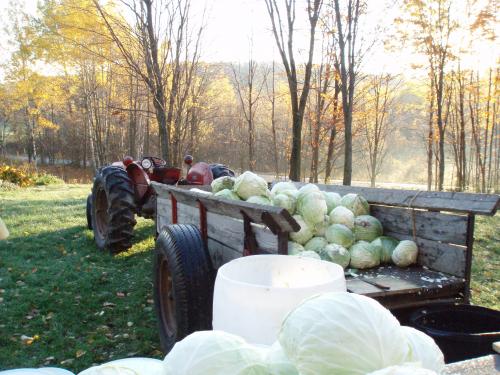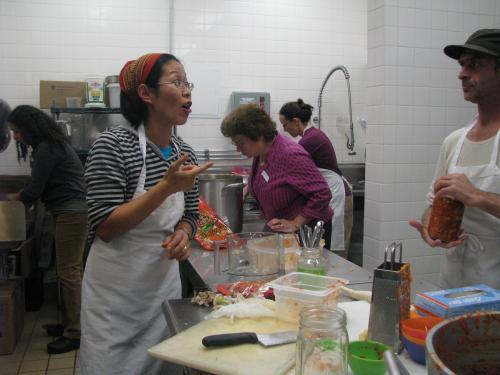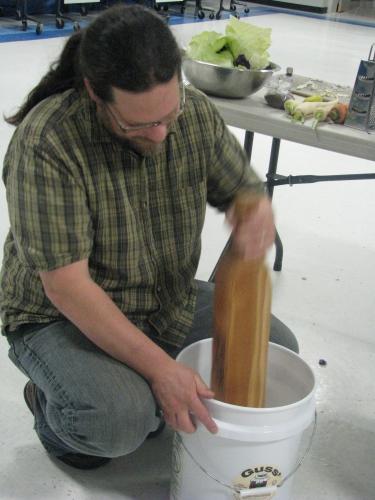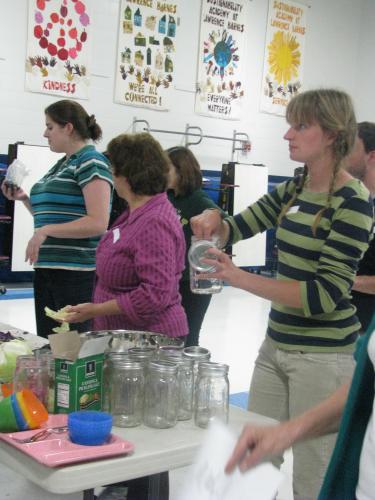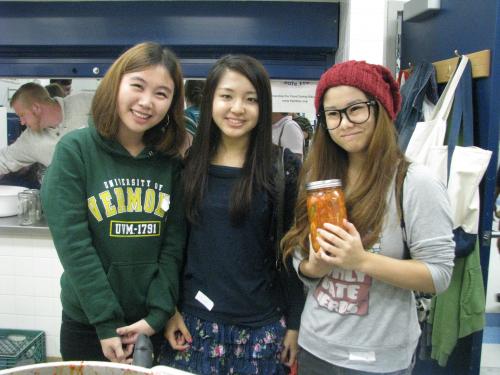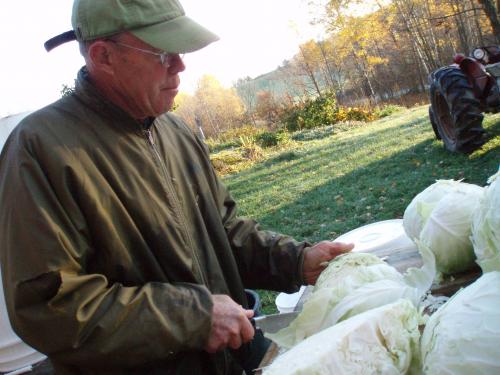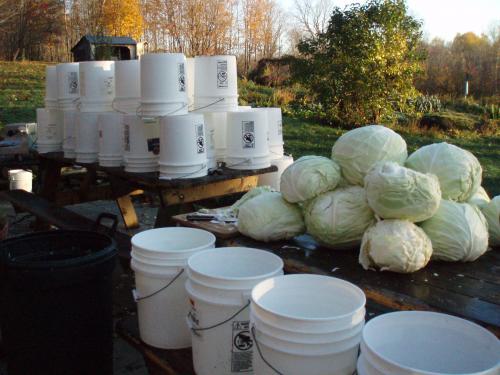Final Preserving the Harvest Class: Kimchi and Sauerkraut
What do Korea and Eastern Europe have to do with each other?
Everything, when it comes to the importance of a pickled cabbage condiment on the table.
Cabbages harvested at Flack Family Farm for kimchi and sauerkraut
Our guest instructors at Tuesday’s final "Preserving the Harvest" class had never met before, but shared stories with a packed room full of participants about the role of fermentation in the food traditions they grew up with.
KOREA:
Chong Ho joking that she put too much spice in the kimchi
Chong Ho Kim talked about how, growing up in Korea, her family made kimchi every year. The kimchi, a mixture of cabbage, onions, ginger, garlic, scallions, rice paste, and lots of red pepper flakes, cured with salt, would be stuffed into the outer leaves of a cabbage and lowered into a large hole in the ground to preserve it through the winter. Every night, a family member would go outside and fetch one of the stuffed cabbages for that night’s meal. The flavor of the kimchi changed over time, from bright and salty to tangy and acid. Even so, it was delicious, and Chong Ho has fond memories of the fried rice with kimchi and stuffed kimchi dumplings the family made with the kimchi as the season wore on.
POLAND:
Jason pounding sauerkraut with one of two City Market-made sauerkraut mashers
Jason Frishman, who has a stand at the Burlington Farmers’ Market called Folk Foods, talked about his Polish grandfather’s ritual of making sauerkraut. His grandfather made sauerkraut of necessity – anything that could be layered with cabbage, from apples to roots, would go into a barrel and preserved with salt for a healthy and frugal part of the diet. When his grandfather learned that sauerkraut and pickled/fermented foods of all kinds were making a comeback, he chuckled that something so essential to his way of eating could be considered trendy.
BURLINGTON, VT:
But then again, hopefully eating locally and learning how to preserve food isn’t a trend, but a lost skill that’s being joyfully revived. At least, that’s the message I got from the final "Preserving the Harvest" class of the season in the heart of Burlington's Old North End, which also featured many young faces from UVM.
Getting ready to pack sauerkraut into jars
UVM students happy wtih the kimchi they can bring home
ENOSBURG FALLS, VT:
If you're interested in learning more about traditional methods of making sauerkraut and kimchi, Flack Family Farm hosts volunteer processing days each fall to help with sauerkraut production. Learn more about dates and how to sign up at Flack Family Farm.
Doug Flack slicing into a fresh cabbage
A beautiful day for making sauerkraut at Flack Family Farm in Enosburg Falls
Sauerkraut
5 pounds cabbage (can be a mixture of white and red cabbages)
3 Tbs. sea salt
Optional:
Seasonings: caraway seeds, dill seeds, cumin seeds, hot peppers, ginger, cilantro/coriander, juniper berries, etc.
Additional vegetables you can substitute for part of cabbage: almost anything that you have on hand – carrots, garlic, onions, beets, turnips, burdock root, daikon radish, even apples!
Shred, chop, or grate vegetables. Place prepared vegetables in a large mixing bowl. Sprinkle salt (and any seasonings) on the veggies as you go. With your hands, mix veggies and seasonings/salt together well. By now they will seem to be getting wet, as the salt draws liquid out of the veggies. As you mix the veggies, squeeze the veggies – this will help the brine creation.
Pack veggies tightly into your fermenting vessel – be it a quart or ½-gallon size mason jar, ceramic crock, or food grade plastic bucket. As you pack the veggies in, tamp them down with your hand, a smaller jar or some other kitchen implement (such as a pestle or an olive oil jar).
Weight the veggies with a plate or lid that fits tightly into the fermenting vessel. The goal here is to keep all vegetables submerged under your brine. If there hasn’t been enough brine created to submerge the vegetables, keep pressing the weighted plate down for a day or so – the brine should be drawn out of the veggies by then. If not, you can always add a homemade brine to submerge (1 tablespoon salt dissolved into 1 cup of water.)
Cover the fermenting vessel with a cloth to keep the flies out and leave it in a safe place, but somewhere where you won’t forget about it.
Check it every other day or so by taking the weighted plate off, rinsing it, and tasting the kraut and the brine. When it is tangy and fermented to your desire, put it in the fridge and eat! It may be to your liking in 7-10 days - or some leave it even longer.
Adapted from Wild Fermentation, by Sandor Katz
Kimchi
8 pounds Napa cabbage
1 cup coarse salt
1 large onion
1 2-inch piece fresh ginger
1 whole head garlic
1 medium daikon radish, grated or thinly sliced
Grated carrots (optional)
1 cup pepper flakes
¼ cup fish sauce
1 cup applesauce
Cooked rice powder (¼ cup rice flour with 2 cups of water, cooked over medium heat until it gets gooey)
1 bunch green onions, sliced
Slice the cabbage lengthwise in half and rinse thoroughly. Slice each half lengthwise again to cut away the tough stem chunks. Cut the cabbage about 2-3 inches length.
Dissolve the coarse salt (1/2 cup for each cabbage) in water (6-7 cups for each cabbage) in a very large container, then put all the cabbage under the water for about 6 hours or until it gets tender. (If you fold the leaves, they bend not break.)
Use food processor and finely grind peeled, onion, garlic, and ginger.
In a large mixing bowl, combine pepper flakes, fish sauce, applesauce, cooked rice powder, and garlic/ginger/onion mixture. Mix well.
When the cabbage is ready(tender), drain it well.
Mix the cabbage, grated daikon, grated carrots (optional), and sliced green onion with the sauce that is made.
Pack the kimchi in a 2-gallon glass jar or equivalent smaller jars, leaving some room, and let it stand a day or so. If it’s bubbling a bit, it’s ready to store in the refrigerator. If you want to keep it for a long time, you can refrigerate right away.
Kimchi is eatable fresh or fermented over weeks.
